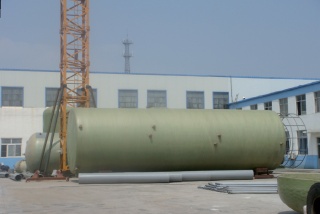PVC welding – A major challenge
 Laizhou, a small town near Qingdao – the city where the sailing competitions were held during the 2008 Summer Olympics Ð is currently undergoing an economic boom.
Laizhou, a small town near Qingdao – the city where the sailing competitions were held during the 2008 Summer Olympics Ð is currently undergoing an economic boom.
This may be attributed in part to its favourable transport connections and to the unique media attention which it attracted in connection with the Games. Xin Li Composite Materials Co. Ltd has been among those companies to benefit from this unparalleled opportunity and has greatly extended its product range and sales area. It has transformed itself from a simple supplier of corrosion-resistant containers to a complete provider of waste water treatment plants for the chemical, medical and metal industries. Xin Li now maintains a network of branches covering western China, including the far north.
PE and PVC are used in almost all products made by Xin Li. Some of the prefabricated products are manufactured using extrusion processing or injection moulding. However, these processes are only suitable for relatively small components and for a limited range of shapes. There has been steadily increasing demand for large containers and pipes with complex forms in the Chinese market.
Extrusion welding is the method of choice to join these parts.
At Xin Li, PVC pipes are welded with the WELDPLAST S2 PVC hand extruder from Leister. Its display shows both the temperature in the weld zone and for the pre-heat hot air. PVC is very sensitive to fluctuations in temperature during welding; improper temperature control can lead to weak weld joints or overheating. ThatÕs why the WELDPLAST S2 PVC is equipped with an electronic temperature control. No manufacturer can afford to have welding quality issues when producing large containers or large-diameter continuous piping. This is why Xin Li has chosen to use Leister PVC hand extruders Ð in fact, it had been waiting for the launch of the product since autumn 2008.
Major projects are often executed in very tight timeframes, which puts those working on material processing under a great deal of pressure. Liu Maokai, Vice President of Xin Li, recalls that prior to using Leister PVC hand extruders, each seam had to be welded several times. Xin Li’s president and technical director visited the trade fair stand of official Leister distributors Digital Steel Company at Chinaplas 2009. There they saw the WELDPLAST S2 PVC hand extruder in action, and were able to test it themselves straightaway. They were so impressed by the quality of the welding seam and the efficiency of the machine that they ordered two machines the very next day. Shortly afterwards they sent another order, bringing the total of these machines at Xin Li to five. The performance and reliability of the WELDPLAST S2 PVC deliver a serious competitive advantage for Xin Li. The company can now tender competitively for even the most technically demanding projects.
As a general rule, pipes with a diameter of less than one metre are assembled at the factory. Larger elements are welded directly at the construction site. With the WELDPLAST S2 PVC, elbow fittings and T-fittings can be welded very easily. The finished welding seam is then polished to achieve a good surface quality.
Xin Li also has a FUSION 2 hand extruder, which was in use before the WELDPLAST S2 PVC for the welding of HDPE pipes. Both hand extruders enable the relevant welding parameters (temperature and output), to be quickly adjusted according to the material used, resulting in consistent, reproducible welding results.
Despite a slowing economy, Xin Li is receiving more orders than ever before. Liu Maokai attributes these increased orders to the considerable investments made by the Chinese government and to his Leister equipment, which, thanks to its top performance and reliability, is highly economical to operate. Furthermore, the production of pipes for waste water treatment plants is the result of a growing tendency to invest in protecting the environment LeisterÕs hand extruders help Xin Li to keep pace with this trend.
nextSTEP
Visit: www.carrgroup.co.nz



